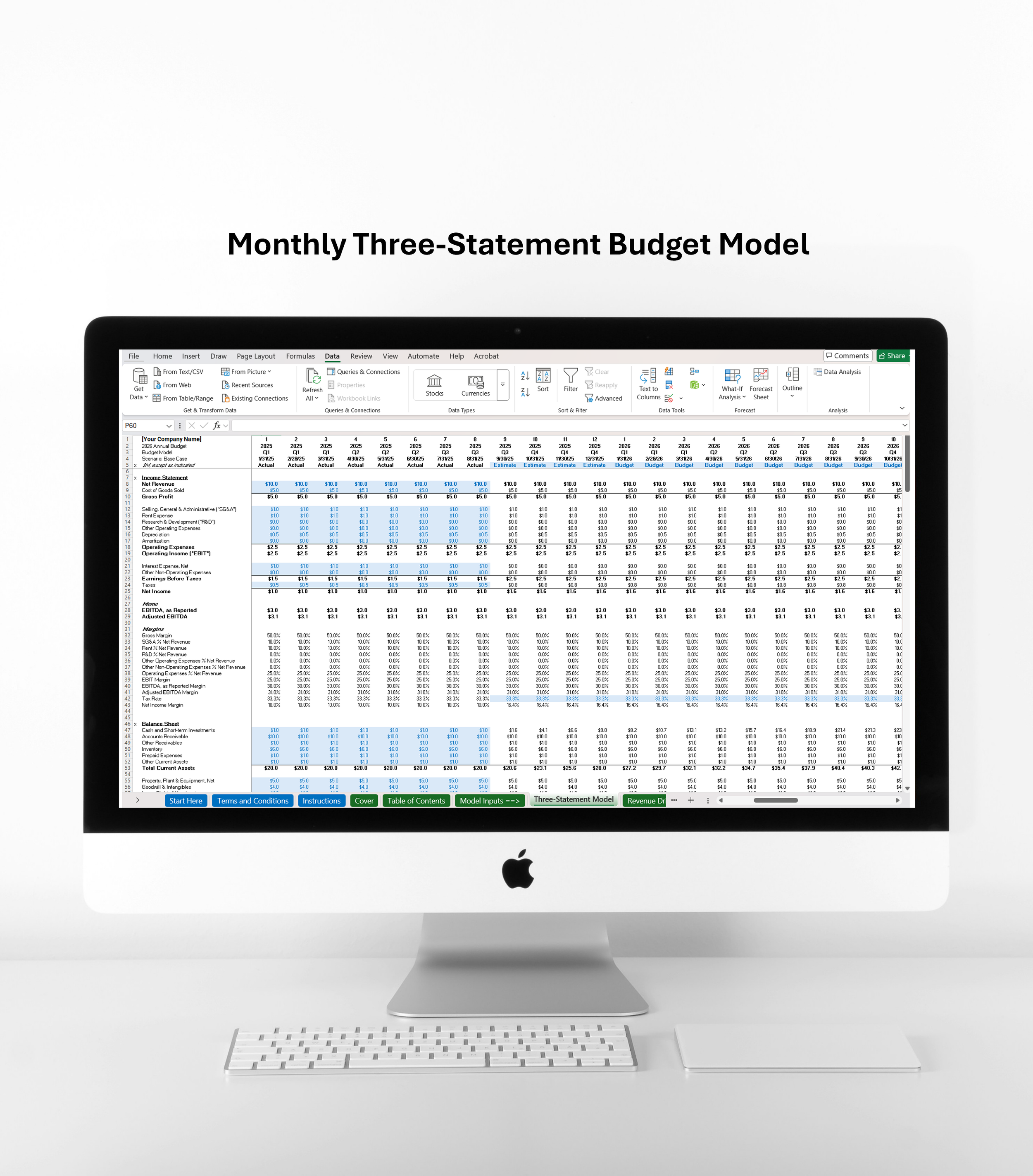AI-Generated Financial Models: Should You Trust an AI-Model with your Business Decisions?
Recent news about AI-generated financial models has prompted an engaging discussion in the financial services and investment banking industries about the value and impact of financial modeling. OpenAI’s project “Mercury” has enlisted junior investment bankers to train its AI model. Anthropic recently launched Claude for Financial Services with features that build financial models directly in Microsoft Excel.
But there is a critical question that founder-owned and mid-sized businesses must answer: is AI-generated financial modeling the right solution to help make your company’s business decisions?
The Promise of AI-Generated Financial Models
The pitch sounds compelling: have a large language model like ChatGPT or Claude build you a financial model, and within minutes you have projections, financial analysis, and downloadable Excel files. It's fast, easy, and requires no specialized financial modeling or Excel skills.
However, this workflow masks the true intention of WHY companies need robust financial modeling in the first place - these models are essential tools that support critical business decisions. The model itself is useless without the underlying understanding of the key drivers of your specific business, the specific initiatives that are going to help drive growth and efficiency gains, and a detailed understanding of how to translate the financial model insights into actionable plans. AI may someday be able to tell you how to perform open-heart surgery, but it does not mean you should.
Some Challenges with AI-Generated Financial Models
1. The Black Box Problem
When ChatGPT or Claude generates a financial model for you, you're getting the output without the effort and intention that comes with building the financial drivers, incorporating the specific operational or financial initiatives that are part of your long-term plan, or considering the interconnectedness of your strategic plan. The formulas, assumptions, and connections are determined by an algorithm, not by someone who understands your specific business dynamics.
When investment bankers or your corporate finance team build a model, the revenue, cost, working capital, capital allocation and other drivers are specified as assumptions that can be adjusted. The baseline drivers should be chosen carefully given your company’s specific operations as well as the macroeconomic operating environment.
If you have external stakeholders, such as creditors or investors, you’ll need to be able to competently explain why the model is structured the way it is. If you didn't build it, it will be much more difficult to defend it.
2. Lack of Business-Specific Logic
AI models are trained on recognizing broad patterns from hundreds to thousands of financial statements. They're excellent at replicating standard structures but can struggle with the nuances that make your business unique such as:
Unique revenue drivers
Seasonality in your sales cycle
Complex cost structures with multiple drivers
Industry-specific metrics and ratios
Custom KPIs that matter to your stakeholders
If your financial model is a generic template, but it fails to capture the levers that actually drive your business performance, it doesn’t adequately serve your needs.
3. Transparency Gap
Anthropic emphasizes that Claude requires a "human in the loop" and is not intended for autonomous financial decision-making. But here's the problem: if you don't understand how the model works, you can't effectively be that human in the loop.
Can you audit the formulas for accuracy?
Can you trace how a change in one assumption flows through the entire model?
Can you identify errors and allow-for or correct circular references?
Can you modify the model as your business evolves?
4. The Iteration Problem
Business planning isn't a one-time event. Effective financial modeling needs to:
Test different scenarios
Update assumptions on a regular basis
Add new product lines or revenue streams as your business evolves
Consider additional headcount or business units as your business grows
Plan capital raises with different debt and equity structures
Model strategic decisions such as the impact of an acquisition
Each iteration of an AI-generated financial model requires regeneration and rechecking. What should take minutes can turn into many hours of prompt engineering and model verification.
Why Founder-Owned and Mid-Sized Businesses will Benefit from a Different Approach
The businesses who will likely find AI-generated financial models most intriguing are precisely those that can least afford mistakes.
Founder-owned businesses need models that:
Reflect the founder's deep understanding of business drivers
Support a strong understanding of the business’ cash flow to drive decision-making about when to reinvest vs. distribute earnings
Model equity structures for accurate succession planning
Provide transparency for family members, lenders, or other investors involved in the business
Mid-sized businesses ($10M-$1B revenue) need models that:
Bridge the gap between startup simplicity and enterprise complexity
Support institutionalization of the financial planning process
Provide credibility with banks, external investors, or strategic acquirers
Scale with the business without requiring complete rebuilds
The Better Alternative: Fully Connected Excel Templates
A well-designed, fully connected three-statement model template offers everything AI promises, plus what it can't deliver:
Why "Fully Connected" Matters
A proper financial model is an integrated system where:
Revenue and operating expenses assumptions flow to cash flow
Changes in working capital or capital allocation assumptions flow to cash flow
Cash flow drives debt balances to capture borrowing and repayment of your company’s credit facility
Debt balances calculate interest expense which flows back to the income statement
Everything reconciles automatically
Explore our Digital Solutions
Key Advantages for Your Business
1. Greater Transparency
Hard-coded inputs are highlighted and differentiated from calculated results
Every formula is visible and auditable
You understand how changes flow through the entire model
You can explain your logic to key decision-makers and stakeholders
2. True Customization
Built once to match your specific business model
Easily modified as your business evolves
Incorporates your industry's best practices
Reflects your actual chart of accounts structure
3. Institutional Knowledge
The financial model becomes a strategic asset for your company’s decision-making
New team members can learn how your business works
Historical assumptions and decisions are well-documented
Knowledge doesn't leave with turnover of consultants or employees
You are not dependent on continuity of AI models
4. Scenario Planning
Our premium three-statement model incorporates a base case, upside, and downside scenario for better risk management. This framework allows decision-makers to:
Test multiple scenarios to measure the impact on operating performance and cash flow
Compare multiple options side-by-side
Model complex “what-if” analyses
5. Protect Data Integrity during Integration
Maintain your company’s privacy when importing actual data from your accounting system
Structure KPIs, investor reports, and board decks so they are useful - - but not easily shared with those who shouldn’t have access
Prepare loan covenant and compliance certificates
6. Create Long-Term Value
Investing in a robust financial model is a one-time investment with long-term benefits
Your model improves with use and refinement
Create a competitive advantage through better planning and superior execution
A well-structured and personalized model is a valuable asset in the fundraising or M&A process
The Right Role for AI in Financial Modeling
This isn't an anti-AI argument. AI has valuable roles in financial analysis:
Data extraction from unstructured sources
Pattern recognition in historical results
Anomaly detection in financial statements
Research assistance for industry benchmarks
But the core financial model - the engine that drives your planning, decision-making, and stakeholder communication - needs to be something you understand, control, and can defend.
Making the Right Choice for Your Business
Ask yourself these questions:
Do you need to explain your model to banks, investors, or board members?
If yes: You need transparency that AI can't provide
Will your business model evolve over the next 2-3 years?
If yes: You need a customizable foundation, not regenerated outputs
Do you want a long-term value creation plan that you can hold your teams accountable to?
If yes: You need a customized model that incorporates your plans and the KPIs you need to deliver on the growth and value creation plan
Do you make significant decisions based on financial projections?
If yes: You need confidence in the underlying logic and assumptions
Are you planning to raise capital, secure lending, or pursue M&A?
If yes: Sophisticated parties will dig into your financial model's details, and you’ll need to understand and defend your assumptions to be successful
Conclusion: The Tool That Matches Your Ambitions
AI is transforming financial services, and large investment banks with teams of financial analysts can wisely use AI to accelerate standardized modeling tasks. But founder-owned and mid-sized businesses need something different to add the most value.
You need a financial model that:
Reflects your unique understanding of your business drivers
Provides transparency and it defensible with key stakeholders
Builds institutional capabilities and scales with your growth
Becomes an asset that will evolve with your unique needs over time – not something that continually needs to be regenerated
A well-designed, fully connected three-statement template delivers all of this. It requires a modest upfront investment to customize to your needs, but it pays dividends every month as you use it to make better decisions, communicate more effectively, and make informed decisions for your business.
The question isn't whether AI will play a role in your financial planning. It will. The question is whether the core engine of your planning will be something you understand and control, or a black box that you hope got it right.
For businesses building for the long term, the answer is clear.
Ready to Build Your Financial Planning Foundation?
We offer professionally designed, fully connected financial model templates specifically tailored for private companies in these industries:
Consumer discretionary
Consumer staples
Industrial
Information technology
Communication services
Healthcare
Energy
Each template includes a guide on how to use the model and the ability to add-on a 1-hour expert consultation or more robust implementation support.
Keene Advisors is a full-service financial advisory and investment banking firm with over $45 billion in successful mergers and acquisitions, capital raising, and restructuring advisory transactions. We have produced thousands of bespoke financial models for clients that are now available as low-cost digital solutions. From fully-connected three-statement models, to discounted cash flow valuation, to competitor benchmarking, reporting has never been more accessible.





